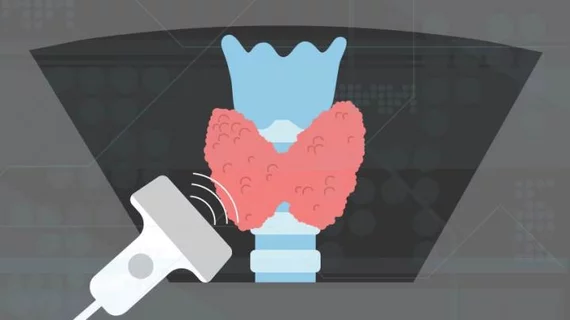Which risk stratification system is best for classifying thyroid nodules?
There are a number of stratification systems for classifying malignancy risk of thyroid nodules identified on ultrasound, but a new meta-analysis suggests that the performance of one surpasses the rest.
The American College of Radiology Thyroid Imaging Reporting and Data System (ACR TI-RADS) bested five other stratification systems in an analysis of 39 studies and nearly 50,000 patients.
Corresponding author of the new analysis Se Hwan Hwang, MD, PhD, from the Department of Otolaryngology-Head and Neck Surgery at Bucheon St. Mary's Hospital in Korea, and co-authors explained the need for a structured comparison of these systems in order to optimize patients’ assessments:
“These guidelines provide algorithms for deciding which nodules warrant FNA versus ultrasound follow-up or no further evaluation,” the group wrote. “However, the approach for classification of suspicious ultrasound features as well as the threshold nodule sizes for determining the need for FNA vary among the systems, confounding data interpretation and communication of risk levels.”
The analysis, published in the American Journal of Roentgenology, compared the following six stratification systems:
American Association of Clinical Endocrinologists/American College of Endocrinology (AACE/ACE)
American College of Radiology Thyroid Imaging Reporting and Data System (ACR TI-RADS)
American Thyroid Association (ATA)
European Thyroid Association Thyroid Imaging Reporting and Data System (EU-TIRADS)
Korean Thyroid Association/Korean Society of Thyroid Radiology Thyroid Imaging Reporting and Data System (K-TIRADS)
Thyroid Imaging Reporting and Data System developed by Kwak et al. (Kwak TIRADS)
Researchers ranked the systems based on the results of 39 different published studies according to their accuracy for cancer detection, risk of bias and sensitivity and specificity at the system’s highest performing threshold.
Image quality was deemed good to fair for all systems. ACR TI-RADS was found to yield the highest sensitivity and specificity, followed by K-TIRADS. Overall, at their highest thresholds, the systems’ sensitivity and specificity ranged between 65 to 77% and 82 to 90%.
Many thyroid nodules undergo fine needle aspiration (FNA) to rule out malignancy, but few are determined to be cancerous. The authors suggest that their comparative analysis could help to limit some of these unnecessary FNAs in the future by better informing risk stratification system implementation and updates.
The study abstract is available here.

